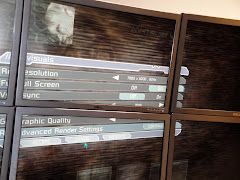Anand of
Anandtech.com got it right. We had been developing GPUs with DisplayPort (DP) on them, and found that we never had enough DP outputs. Because of the electrical characteristics of DP, we had to have one physical DP output from the GPU to every connector. With analog signals such as those used in VGA, you can tie more than one connector to a single GPU output. You can't do that with DP. We had at least five DP outputs per chip, and sometimes six DP outputs. Inevitably the question came up: "Gee what if we used some of those extra DP outputs to drive more than two monitors." (
Note: one architect is the source of almost all of these stimulating questions.)
We had had two mobile customers asking for three display support for quite awhile. One had been asking back as far as 1998 (I know, because it was me they made the original request to). At least once per year this request came up, and at least once per year I turned them down. We didn't support their request because quite frankly the cost was exorbitant (those analog outputs take a lot of die area, which means the cost goes up).
As we refined the definition of the Evergreen products, this latent request was nagging at me, but not so much as the stimulating architect's question. For various reasons one day I had the sudden impulse, the conviction to do more than two displays. The reasons are the subject of another post, not this one. The observation that DP costs less die area (think money) than analog does made it easier for me to make the leap. When I said we were going to do this, the immediate conclusion was, "Great, we'll do four monitors". I said, "no we will do six." The question, "Why six?". My reasoning was two-fold.
- First, four was the obvious improvement over two displays (Note: Why? it's that power of two thing). If what we were doing leaked, the obvious conclusion would be that we were doing four. I wanted to ensure that even if there was a leak, there would be little possibility that we would be competitively leapfrogged.
- Second, I thought there was no "constellation" where four made sense from a gaming perspective. You always had what I called "the crosshair" problem" with 2Wx2L or 4W1H. The observation is that for gaming the number of panels in any dimension needs to be odd to minimize bezel interference, to not have "the crosshair problem".
Why not more than six displays? That's an easy answer: die area, package ball-outs, board real-estate. In other words money. But six displays does lead to some interesting discussions. And the "crosshair problem" is less of a problem than you might think. These are topics for other postings.
More...
